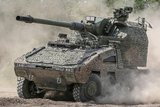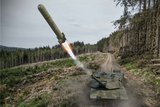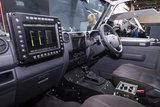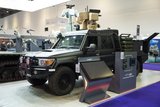Layered Defence: How new technologies are enhancing armoured vehicle survivability and manoeuvrability (Studio)
Brought to you in partnership with Rafael
For more than 20 years, the global war on terror saw armed forces hyper-focused on protecting armoured fighting vehicles (AFVs) from rocket-propelled grenades (RPGs) and improvised explosive devices.
Following Russia’s latest invasion of Ukraine in February 2022, the modern battlefield has evolved dramatically. Commercial and weaponised drones, loitering munitions, improved anti-armour guided munitions and tank-fired kinetic energy (KE) projectiles are reshaping the nature of conflict.
Today, this hybrid mix of threats is forcing the most modern armed forces to consider a more layered approach to the survivability of AFVs to ensure freedom of manoeuvre across the battlefield.
According to Shephard’s Land Warfare Expert, Chris Foss, for every main battle tank (MBT) destroyed in Ukraine, a further two light armoured vehicles are also lost – a statistic driving more armed forces to furnish their newer AFVs with defensive measures.
Warning that no AFV will ever be ‘100 per cent survivable’, Foss explained: ‘The threat is always changing, and that’s why Israel in 2007 started developing an active protection system [APS) designed not only to protect against RPGs, but also ATGMs [anti-tank guided munitions].
‘But since then, missiles have increased in velocity, and also you’ve got the threat of tank-launched [KE] projectiles, which has led to the further development of the IDF’s Trophy APS, enabling it to engage both armour-piercing RPGs, ATGMs and in some cases, tank-launched projectiles,’ Foss explained.
Comprehensive Solutions for AFV Survivability
Guy Bitton, Head of Business Development at Rafael’s Land & Manoeuvre Directorate, said the world is witnessing a resurgence in demand for the ‘total protection’ of AFVs, encompassing passive, active and reactive solutions.
‘Total protection demands multiple systems. They could be lethal, survivable or a combination of both. In the IDF, we understand that if you have the survivability on your fighting vehicle, you can survive and complete your mission. But if you don’t, you’re a target.’
Rafael’s solutions include its suite of ‘Armor Shield’ products, which stretch from passive through to explosive reactive armour (ERA) add-ons, providing AFVs with multi-hit capability against even KE projectiles. Customers include the US Army and US Marine Corps Bradley and Stryker AFVs.
The active protection system, TROPHY APS, offers automatic hostile fire detection and 360° coverage with a wide angle of elevation, providing defence at both short and long ranges, even while on the move. According to Rafael, it neutralises all known threats, including recoilless rifles, anti-tank guided missiles (ATGMs), anti-tank rockets, HEAT rounds, RPGs, and low-signature threats.
‘Together, these capabilities deliver the most advanced protection for both crews and platforms in the field,’ the company said.
Addressing the Top-Attack Threat
Foss argued that one of the most important lessons emerging from the Ukraine conflict is the threat of ‘top attack’ by ATGMs, weaponised drones and other loitering munitions.
‘Even some American-supplied vehicles have been deployed with very crude, often homemade devices to try and stop these incoming missiles. So there’s a lot of effort looking at how we can provide 360-degree protection, but also protection in the vertical plane.
‘Rafael’s Trophy is being tested in real environments by Israel and other countries who have already selected it for MBTs. It’s now also been developed for installation on smaller vehicles,’ Foss concluded.
In the evolution of the Trophy APS, Bitton likens its development to the ongoing progression of Apple’s iPhone.
‘The iPhone of today knows how to do much, much more,’ he said. ‘This is the same as the Trophy we sold to the IDF in 2007 for the Merkava MBT. But today, it’s a totally different system because when you regularly interact with enemy technology, they present new threats, whether RPGs, ATGMs or loitering munitions.’
The Growing Demand for Layered Defence Systems
Highlighting Trophy’s recent operational successes in Gaza, Bitton is quick to stress the importance of layering AFVs with additional capability to optimise survivability in even the most contested operating environments.
‘We know today from Ukraine that you can be defeated by RPGs, ATGMs and loitering munitions on the same battlefield. So, passive and reactive armour is not enough. We need another layer,’ Bitton explained.
‘If you have all three layers [passive, reactive and active], you are on top and can be at the tip of the spear in terms of capability. This is the case for the Merkava MBT and Namer APC. It doesn’t matter if it’s Abrams, Bradley or Leopard, you are a target on the battlefield without this kind of capability.’
As a further extension of the layered approach to ‘total protection’, Bitton described additional capabilities for AFVs, which include the integration of counter-drone solutions equipped with a jammer, 30mm cannon, ‘Lite Beam’ high energy laser (HEL) or high power microwave (HPM) effector.

Bitton said that solutions are light enough in weight and small enough in form factor to be integrated onboard 6x6 and even 4x4 tactical ground vehicles.
‘Clients can choose the most appropriate effector. We build it like “Lego”, and you can build your own system. There is no one solution for all of these threats.
‘But clients tell us they don’t necessarily want to put an APS system on each 4x4 or 6x6 vehicle. Instead, they need a solution that can create a bubble of protection. And this is why we created a modular, lightweight solution with multiple effectors,’ he said.
Preparing for the Next Decade of Threats
As battlefield threats continue to evolve, the need for comprehensive, layered defence systems has never been more critical. For AFVs to remain effective, armed forces must prioritise investments in these new technologies, ensuring readiness for tomorrow's challenges.
‘Customers are coming to us asking for more capability, whether it be passive, reactive and/or active. Our main lesson learned is that customers must give their vehicle fleets the capabilities to defeat all kinds of “surprise” threats,’ Bitton remarked.
‘At Rafael, we are trying to understand what the next decade looks like and bring capabilities to defeat these threats, allowing AFVs to manoeuvre fast, aggressively and strong enough to block and break the enemy’s lines.’
More from Studio
-
![Light Reconnaissance Strike – enabling a vital mission set (Studio)]()
Light Reconnaissance Strike – enabling a vital mission set (Studio)
A new system-of-systems concept will unlock digital integration of sensors and weapons for Light Forces, allowing them to shape the battlefield environment on their own terms and upgrade legacy platforms.
-
![Energy evolution: How laser defence systems are powering the next phase of air defence (podcast)]()
Energy evolution: How laser defence systems are powering the next phase of air defence (podcast)
Laser-based air defence is moving from promise to deployment as global threats evolve. In this special podcast, we explore how high-energy laser systems are reshaping interception strategies.
-
![Unlocking the potential of Light Forces in modern warfare (Studio)]()
Unlocking the potential of Light Forces in modern warfare (Studio)
The Ukraine conflict has highlighted the strategic importance of “Light Forces” – rapidly deployable dispersed units, able to conduct an expanding range of mission sets. What technologies and equipment are needed to ensure their success in combat?
-
![Resilience, adaptiveness and collaboration vital for success in space (Studio)]()
Resilience, adaptiveness and collaboration vital for success in space (Studio)
Speakers at the Defence In Space Conference (DISC) 2025 highlighted the critical and evolving role of space in national security, defence and the global economy.
-
![Precision on Demand: The New Age of Loitering Weapons (Podcast)]()
Precision on Demand: The New Age of Loitering Weapons (Podcast)
Loitering munitions provide vital capabilities in the disrupted and unpredictable modern battlespace, from real-time ISR to a virtually “on demand” strike capability. Rafael is looking to the future of the technology, empowering systems to operate with increasing autonomy in hostile environments.
-
![Beyond Survivability: How Active Protection Systems Are Empowering Commanders (Podcast)]()
Beyond Survivability: How Active Protection Systems Are Empowering Commanders (Podcast)
As threats diversify and intensify, APS are proving essential not just for vehicle protection but also for enhancing operational freedom, effectiveness and mission success in contested environments.

























